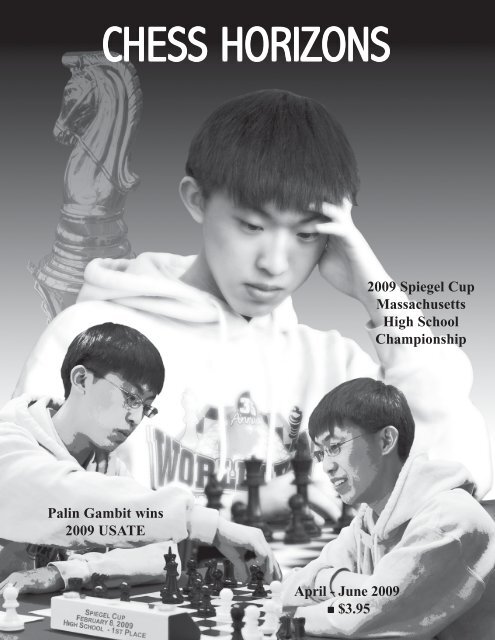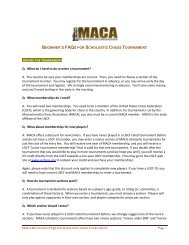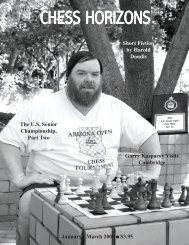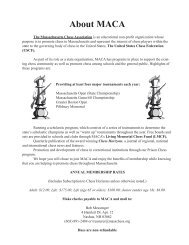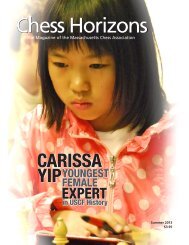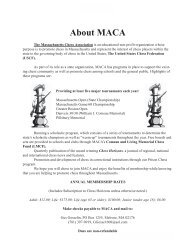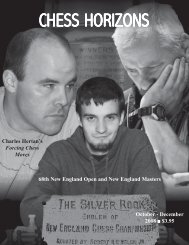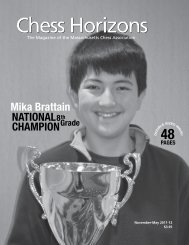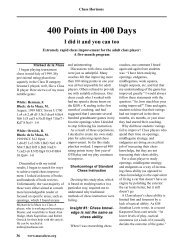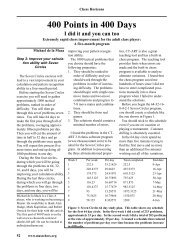chess horizons chess horizons chess horizons chess horizons - The ...
chess horizons chess horizons chess horizons chess horizons - The ...
chess horizons chess horizons chess horizons chess horizons - The ...
Create successful ePaper yourself
Turn your PDF publications into a flip-book with our unique Google optimized e-Paper software.
CHESS Chess HORIZONS<br />
Horizons<br />
2009 Spiegel Cup<br />
Massachusetts<br />
High School<br />
Championship<br />
Palin Gambit wins<br />
2009 USATE<br />
April - June 2009<br />
• $3.95<br />
April - June 2009 1
Chess Horizons<br />
About MACA<br />
<strong>The</strong> Massachusetts Chess Association is an educational non-profit organization whose<br />
purpose is to promote <strong>chess</strong> in Massachusetts and represent the interest of <strong>chess</strong> players within the<br />
state to the governing body of <strong>chess</strong> in the United States, <strong>The</strong> United States Chess Federation<br />
(USCF).<br />
As part of its role as a state organization, MACA has programs in place to support the existing<br />
<strong>chess</strong> community as well as promote <strong>chess</strong> among schools and the general public. Highlights of<br />
these programs are:<br />
Providing at least four major tournaments each year:<br />
Massachusetts Open (State Championship)<br />
Massachusetts Game/60 Championship<br />
Greater Boston Open<br />
Harry Nelson Pillsbury Memorial<br />
Running a scholastic program, which consists of a series of tournaments to determine the<br />
state’s scholastic champions as well as “warm up” tournaments throughout the year. Free boards and<br />
sets are provided to schools and clubs through MACA’s Living Memorial Chess Fund (LMCF).<br />
Quarterly publication of the award winning Chess Horizons, a journal of regional, national<br />
and international <strong>chess</strong> news and features.<br />
Promotion and development of <strong>chess</strong> in correctional institutions through our Prison Chess<br />
program.<br />
We hope you will chose to join MACA and enjoy the benefits of membership while knowing<br />
that you are helping to promote <strong>chess</strong> throughout Massachusetts.<br />
ANNUAL MEMBERSHIP RATES<br />
(Includes subscription to Chess Horizons unless otherwise noted.)<br />
Adult: $12.00; Life: $175.00; Life (age 65 or older): $100.00; Junior (under age 18): $6.00.<br />
Make checks payable to MACA and mail to:<br />
Bob Messenger<br />
4 Hamlett Dr. Apt. 12<br />
Nashua, NH 03062<br />
(603) 891-2484 or treasurer@mass<strong>chess</strong>.org<br />
Dues are non-refundable<br />
April - June 2009 3
Chess Horizons<br />
IN THIS ISSUE<br />
Cover Photo by Tony Cortizas:<br />
2009 Massachusetts High School Champion Felix Yang<br />
MACA<br />
Massachusetts Chess Association<br />
www.mass<strong>chess</strong>.org<br />
OFFICERS<br />
Here & <strong>The</strong>re/6<br />
Vigorito on Chess/8<br />
<strong>The</strong> January Experiment<br />
IM David Vigorito<br />
Display and Play/12<br />
Vertical Chess Art<br />
Mark Donlan<br />
Palin Gambit wins 2009 USATE/13<br />
Tournament Report and Games<br />
FM Paul MacIntyre<br />
Spiegel Cup/18<br />
Tournament Report, Photos, & Games<br />
George Mirijanian<br />
100th RI Pawneater/24<br />
Tournament Report and Photos<br />
Eric Berkey<br />
Club and Tournament News/26<br />
All the Chess that’s Fit to Print<br />
PRESIDENT<br />
Maryanne C. Reilly<br />
VICE PRESIDENT<br />
Donna M. Alarie<br />
21 Blueberry Lane<br />
Rutland, MA 01543-1320<br />
(508) 847-8574<br />
TREASURER<br />
Robert D. Messenger<br />
4 Hamlett Dr. Apt. 12<br />
Nashua, NH 03062<br />
(603) 891-2484<br />
CLERK<br />
Kenneth R. Ballou<br />
27 Fenway Drive<br />
Framingham, MA 01701-4012<br />
(508) 788-2771<br />
MEMBERSHIP SECRETARY<br />
Robert D. Messenger<br />
CONTACT ADDRESS<br />
www.mass<strong>chess</strong>.org/contact<br />
COORDINATORS<br />
ARCHIVIST: Vacant<br />
BUDGET: Donna Alarie<br />
CLUB: George Mirijanian<br />
COLLEGE: Vacant<br />
DATA PROCESSOR:<br />
Robert Messenger<br />
EDUCATON: Stephen Dann<br />
FUND RAISING: Brian Lafferty<br />
LEAGUE: Vacant<br />
LIVING MEMORIAL: Brian Lafferty<br />
MASTER CHESS: Donna Alarie<br />
PARLIAMENTARIAN:<br />
Brian Mottershead<br />
PRISON: Steven Frymer<br />
PROMOTION: Brian Lafferty<br />
PUBLICATION: George Mirijanian<br />
SCHOLASTIC: Maryanne Reilly<br />
TOURNAMENT: Ken Ballou<br />
VOLUNTEER: Stephen Dann<br />
April - June 2009 5
Chess Horizons<br />
Palin Gambit wins 2009 USATE<br />
FM Paul MacIntyre<br />
It has occurred on President’s Day<br />
weekend now for thirty-nine years.<br />
Known to most as the United States Amateur<br />
Teams East, the USATE, or just “<strong>The</strong><br />
Teams,” it has recently been upgraded,<br />
somewhat immodestly, to “World Amateur<br />
Team Tournament” status.<br />
This year about 280 teams of four players<br />
each, in a hotel in Parsippany, New<br />
Jersey, vied for proverbial peanuts –<br />
plaques, trophies, and clocks. First place<br />
netted a plaque, four individual trophies,<br />
four Excalibur clocks, and entry into the<br />
playoff matches with the winners of the<br />
Amateur Team Championships of the<br />
North, South, and West for the national<br />
title.<br />
<strong>The</strong> winners of that tournament receive<br />
wristwatches. I know that because I have<br />
seen the one Charles Riordan proudly<br />
wears from his 2007 victory with his<br />
team, My G8 Predecessors, which included<br />
Alex Cherniack, Lawyer Times,<br />
and Charlie Mays. Second through fifth<br />
places also receive four Excalibur clocks,<br />
as do teams that win the many class<br />
prizes. Special prizes include best mixed<br />
doubles team with two women and two<br />
men, best military team, best senior team,<br />
best college team, etc.<br />
Yet despite the lack of money prizes,<br />
even grandmasters can’t resist this extremely<br />
popular event: Karpov,<br />
Dzindzichashvili, Christiansen, De<br />
Firmian, Seirawan, Izoria have all been,<br />
to name just a few. Each team’s rating<br />
must average at the most 2199.75, as it is<br />
an “amateur” event. Last year a team with<br />
three grandmasters and a five-year-old<br />
boy took first place. While their team rating<br />
average was indeed low enough, they<br />
unknowingly had flouted an old rule at<br />
the teams: there can’t be more than a<br />
1,000 rating point difference between the<br />
third board and the fourth board. For that<br />
reason, it was decided, after all, that they<br />
wouldn’t be able to compete in the national<br />
finals.<br />
So, three grandmasters and a child, a<br />
winning team formula, will no longer be<br />
allowed. So what is the second best winning<br />
formula? Well, a team with two<br />
grandmasters and two weaker players<br />
seems like a good idea, but it has a fatal<br />
flaw. <strong>The</strong> problem is that there are bound<br />
to be times when the weaker bottom two<br />
boards will both lose, and the team will<br />
only draw. This is a big problem, as the<br />
World Amateur Team Tournament is so<br />
competitive that even one draw can ruin<br />
your chances of taking first, and two<br />
draws will definitely do so.<br />
Expert Alan Price is a great proponent<br />
of the “balanced team” approach. He<br />
firmly believes that a team of four players<br />
whose ratings are relatively close is<br />
the one to bet on to win it all. Alan is<br />
perhaps one of the most successful Amateur<br />
Team player/organizers alive, as he<br />
has against all odds put together two winning<br />
teams now. <strong>The</strong> first was Light Blue<br />
in 1998:<br />
From <strong>The</strong> Washington Times, March<br />
21, 1998:<br />
Offering a prize “fund” that wouldn’t<br />
stretch the budget of a neighborhood lemonade<br />
stand, the U.S. Amateur Team<br />
Photo: Brian Hulse's camera<br />
<strong>The</strong> Palin Gambit: I can see checkmate from my house (l-r)<br />
Alan "chaos theory" Price, Libardo "Ng5" Rueda, Brian "mercy killer" Hulse, Paul "I'm not dead yet" MacIntyre<br />
April - June 2009 13
Chess<br />
Horizons<br />
Championship East has developed into<br />
one of the biggest attractions on the<br />
American <strong>chess</strong> calendar. Last month’s<br />
edition was no different: A record 269<br />
teams and 1,305 players knocked heads<br />
in Parsippany, N.J., highlighted by FIDE<br />
champ Anatoly Karpov holding down<br />
first board for the WWW Chess<br />
Superstore team. Both Karpov and his<br />
team went 6-0, but they were edged out<br />
on tiebreaks by Light Blue (Dylan<br />
McClain, Nathan Resika, Brian Hulse and<br />
Alan Price).<br />
This year, 2009, on February 14-16, I<br />
had the pleasure of playing first board on<br />
Alan’s second winning team effort, <strong>The</strong><br />
Palin Gambit: I can see checkmate from<br />
my house. It was composed of:<br />
Paul “I’m not dead yet” MacIntyre –<br />
(2320) Rumors circulated around the hall<br />
in the early rounds that MacIntyre had<br />
lost three games in a row. “His team must<br />
be out of the running by now – Hey, how<br />
come they’re still on such a low-numbered<br />
board behind the velvet ropes?”<br />
Board Score: 2–4.<br />
Brian “mercy killer” Hulse – (2200)<br />
This Light Blue veteran taught us all<br />
about how to let the opponent hang himself.<br />
His <strong>chess</strong> playing wisdom in the<br />
realms of personality and psychology<br />
educated us all. Board Score: 3–3.<br />
Libardo “Ng5” Rueda – (2189) Libardo<br />
was junior champion of his home country<br />
of Colombia more than twenty years<br />
ago. He has recently returned to <strong>chess</strong>,<br />
and relies on about three openings books<br />
and raw talent. In this tournament, his<br />
black opponents allowed him to place<br />
knights on g5 in nearly every game, with<br />
deadly results. Board Score: 5½–½.<br />
Alan “chaos theory” Price – (2052) At<br />
home in a shower of tactics, Alan has had<br />
to fight his temptation towards uncontrollable<br />
positions as he makes his way from<br />
2100 to his dream of a master rating. His<br />
mantras include “embrace the dull” and<br />
“avoid shiny objects.” Board Score: 6–0.<br />
Three of us were Boylston players; indeed,<br />
Boylston and Massachusetts talent<br />
abounded at the tournament. George<br />
Mirijanian compiled the following list for<br />
the MACA news of how Massachusetts<br />
players fared individually:<br />
6 - Alan Price<br />
5½ - Libardo Rueda, Roza Eynullayeva,<br />
Andrew Wang, Edward Epp<br />
5 - Denys Shmelov, Alex Cherniack,<br />
Maxwell Schwartz, Will Thalheimer,<br />
Thomas Filipek<br />
4½ - Charles Riordan, Melvin Zhang,<br />
Anatoly Levin<br />
4 - William Kelleher, Arthur Bisguier, Ilya<br />
Krasik, Carey <strong>The</strong>il, Charles Mays, Richard<br />
Rose, Reilly Nathans, Benjamin<br />
Smith<br />
3½ - Timothy Hanke, Natasha<br />
Christiansen<br />
3 - Christopher Williams, Lawyer Times,<br />
Frank Wang, Philip Nutzman, Jake<br />
Garbarino, Gabriel Frieden, Michelle<br />
Chen, Matthew Lee, Srivat Dattatreya<br />
2½ - William G. Michael, Matthew<br />
Phelps, Michael Raphael, Alexander Lee,<br />
Clara Wang, Karl Hahn, Nicholas Plotkin<br />
2 - Paul MacIntyre, Daniel Bartley, Anthony<br />
Andrews, Barry Lai<br />
1½ - Robert Oresick<br />
0 - Daniel Plotkin<br />
In Round One our team was paired way<br />
down against a Massachusetts squad<br />
headed by Jake Garbarino and named,<br />
Those Guys Who Beat Us. As expected,<br />
my three teammates dispatched their opponents<br />
without too much trouble, but my<br />
game was another story. I was handed the<br />
worst upset I’ve suffered in years by Jake<br />
Garbarino (1981), who had the black<br />
pieces. (Actually his pieces were red. I<br />
attribute my loss at least in part to his<br />
psychedelic set.) Luckily for us, the team<br />
didn’t need my help this time.<br />
In Round Two, we faced Robert Hess’s<br />
team, Be Kind, Resign. Hess himself is a<br />
senior in high school with a 2550 rating.<br />
Here, my role was really just to “absorb”<br />
all those extra rating points and allow my<br />
teammates to beat the lower boards. So,<br />
I was duly drubbed, Brian drew, while<br />
Libardo and Alan won versus their 1800-<br />
rated opponents.<br />
In Round Three came the greatest<br />
threat to our chances: a team that more<br />
than rated to draw with us. MCO XVI had<br />
GM De Firmian on board one, GM<br />
Fedorowicz on board two, and two of<br />
their young students on boards three and<br />
four. Unless I or Brian could somehow<br />
nick something off the two giants, our<br />
team’s chances were sunk. I chose to<br />
grovel with white (cue Nobody Does It<br />
Better) in a Moscow Sicilian, trading the<br />
queens early on. Unfortunately, but not<br />
surprisingly, De Firmian’s perfect technique<br />
snuffed me out relatively quickly.<br />
Now all our hopes were pinned on<br />
Brian. Earlier, he had told us that<br />
Fedorowicz was a childhood friend of his,<br />
and that he had had good results against<br />
him on various occasions. Brian played<br />
a Bogo-Indian, and held an ending after<br />
Fedorowicz had invaded deep into<br />
Brian’s queenside, but thanks to Brian’s<br />
deft defense he had run out of objects of<br />
attack and just ended up trading pieces.<br />
<strong>The</strong> knight ending proved to be<br />
unwinnable for either side. Alan and<br />
Libardo beat up on the youngsters, and<br />
we had passed the test!<br />
White: Fedorowicz, John<br />
Black: Hulse, Brian (2200)<br />
USATE (3), Parsippany 2009<br />
Bogo-Indian [E11]<br />
1.d4 Nf6 2.c4 e6 3.Nf3 Bb4+ 4.Bd2 a5<br />
5.g3 O-O 6.Bg2 d5 7.Qc2 Na6<br />
Brian is first to leave book.<br />
8.O-O c5 9.Bg5 cxd4 10.cxd5 Be7<br />
11.Nxd4 Nxd5<br />
<strong>The</strong> intermediary 11…Nb4 12.Qd2 h6<br />
13.Bxf6 Bxf6 14.Nc3 would have allowed<br />
black to avoid an IQP position.<br />
12.Bxe7 Qxe7 13.Nc3 Nab4 14.Nxd5<br />
Nxd5 15.Rac1 Rd8 16.e3<br />
Fedorowicz eschews the IQP position<br />
obtainable after 16.Bxd5, and Fritz 9<br />
agrees that there was no advantage there.<br />
16…e5<br />
cuuuuuuuuC<br />
{rDb4wDkD}<br />
{DpDw1p0p}<br />
{wDwDwDwD}<br />
{0wDn0wDw}<br />
{wDwHwDwD}<br />
{DwDw)w)w}<br />
{P)QDw)B)}<br />
{Dw$wDRIw}<br />
vllllllllV<br />
Black has equalized.<br />
17.Nb5 Be6 18.Qc5 Qxc5 19.Rxc5 b6<br />
20.Rcc1 Rac8 21.Rxc8 Rxc8 22.Rd1<br />
Nf6 23.Na7 Re8 24.Bc6 Rb8 25.a3 Kf8<br />
26.f3 Ng8 27.e4 Ne7 28.Ba4 g6 29.Rd6<br />
Rb7 30.Rd8+ Kg7 31.Nb5 Rd7<br />
32.Rxd7 Bxd7 33.Nc3 Bxa4 34.Nxa4<br />
14 www.mass<strong>chess</strong>.org
Nc8 35.Kf2 Kf6 36.Nc3 Ke6 37.Nd5 f5<br />
38.Ke3 fxe4 39.fxe4 h6 40.Kd3 Kd6<br />
41.Ne3 b5 42.a4 bxa4 43.Nc4+ Ke6<br />
44.Nxa5 Nd6 45.Nc4 Nb5 46.Na3 Nd6<br />
½-½<br />
In Round Four we were paired with<br />
strong college player James Critelli’s<br />
team, Working On A Team, whose second<br />
board was <strong>chess</strong> blogger Abby<br />
Marshall. Alan and Libardo eliminated<br />
their opponents, while I was finally returning<br />
to form, and had a large advantage<br />
when I agreed to a draw with Critelli<br />
to clinch the match. As soon as he saw<br />
that I had taken the draw, Brian really let<br />
Abby off the hook in a very winning position,<br />
but as there was no need to win,<br />
he preferred to offer her a merciful draw.<br />
Alan and Libardo both faced dangerous<br />
young players on boards three and four.<br />
Here are their games:<br />
White: Rabin, Evan (2136)<br />
Black: Rueda, Libardo (2185)<br />
USATE (4), Parsippany 2009<br />
Sicilian Defense [B30]<br />
1.e4 c5 2.Nf3 Nc6 3.Bb5 Qc7 4.O-O e6<br />
4…Nf6 is more popular.<br />
5.c3 Nf6 6.Re1 d5 7.exd5 Nxd5 8.d4<br />
Be7<br />
Things have gone a bit wrong, and<br />
Black must now allow White to play c4<br />
and d5 in order to complete development.<br />
9.c4 Nf6 10.d5 a6 11.Ba4 b5 12.cxb5?!<br />
12.dxc6 was better.<br />
12...axb5 13.Bxb5 Nxd5<br />
Now Black, with a strong knight on d5 and<br />
good central influence has no problems.<br />
14.Ne5 Bb7 15.Bg5?<br />
cuuuuuuuuC<br />
{rDwDkDw4}<br />
{Db1wgp0p}<br />
{wDnDpDwD}<br />
{DB0nHwGw}<br />
{wDwDwDwD}<br />
{DwDwDwDw}<br />
{P)wDw)P)}<br />
{$NDQ$wIw}<br />
vllllllllV<br />
A pseudo-brilliancy that only serves to<br />
activate Black’s position to the max.<br />
15…Bxg5 16.Nxc6 O-O 17.Ne5 Rfd8<br />
18.Qb3 Bf6 19.Nf3 Nb4 20.Na3 Qf4<br />
Chess Horizons<br />
21.Qc4 Qxc4 22.Nxc4 Bxf3 23.gxf3 Nc2<br />
24.a4 Rdb8 25.Rac1 Nxe1 26.Rxe1 Kf8<br />
27.Rb1 Ke7 28.b4 cxb4 29.Rxb4 Bc3<br />
30.Rb3 Ba5 31.Ne5 Rb6 32.Nc6+ Kd6<br />
33.Rd3+ Kc5 34.Nxa5 Rxa5 35.Rd7 e5<br />
36.Rxf7 Rg6+ 37.Kf1 h5 38.Rf5 Kd4<br />
39.Rxh5 Ra7 40.Rh4+ Kd5 41.f4 e4<br />
cuuuuuuuuC<br />
{wDwDwDwD}<br />
{4wDwDw0w}<br />
{wDwDwDrD}<br />
{DBDkDwDw}<br />
{PDwDp)w$}<br />
{DwDwDwDw}<br />
{wDwDw)w)}<br />
{DwDwDKDw}<br />
vllllllllV<br />
42.Ke2 Rc7 43.Rh8 Rh6 44.Rd8+ Rd6<br />
45.Rxd6+ Kxd6 46.f3 Kd5 47.fxe4+<br />
Kxe4 48.Kf2 Kxf4 49.Kg2 Rc2+<br />
50.Kh3 g5 51.Bd7 Ra2 52.Be6 Rxa4<br />
53.Kg2 Ra6 54.Bd7 Ra2+ 55.Kh3 Rc2<br />
56.Be6 Rc3+ 57.Kg2 g4 58.Bd5 Rc2+<br />
59.Kg1 Kg5 60.Bg2 Kh4 61.Kf1 Ra2<br />
62.Kg1 g3 63.h3 Ra1+ 64.Bf1 Rxf1+<br />
65.Kxf1 Kxh3 0-1<br />
White: Price, Alan (2052)<br />
Black: Williams, Jeremiah (1969)<br />
USATE (4), Parsippany 2009<br />
Sicilian Defense [B42]<br />
1.e4 c5 2.Nf3 e6 3.d4 cxd4 4.Nxd4 Nc6<br />
5.Nxc6 bxc6 6.Bd3 Qc7 7.0–0 a6 8.Qe2<br />
d5 9.c4 Nf6 10.e5 Nd7 11.f4<br />
11.Bf4!? Nc5 12.Bc2 Rb8 13.b3 dxc4<br />
14.Qxc4 a5 15.Qc3 Ba6 16.Rd1.<br />
11...Bc5+ 12.Kh1 0–0 13.Nd2 Be7 14.b3<br />
Nc5 15.Bc2 a5 16.Bb2 Rb8 17.Bc3 Rd8<br />
18.Nf3 Ba6 19.Ng5!? Bxg5!?<br />
19...g6 20.Qe1.<br />
20.fxg5 d4<br />
cuuuuuuuuC<br />
{w4w4wDkD}<br />
{Dw1wDp0p}<br />
{bDpDpDwD}<br />
{0whw)w)w}<br />
{wDP0wDwD}<br />
{DPGwDwDw}<br />
{PDBDQDP)}<br />
{$wDwDRDK}<br />
vllllllllV<br />
Black is threatening to win a piece with<br />
a pawn fork on d3.<br />
21.Bxa5!<br />
First deflect the queen away from its<br />
defense of f7.<br />
21...Qxa5 22.Bxh7+!<br />
<strong>The</strong>n go after the king.<br />
22...Kf8<br />
22...Kxh7? 23.Qh5+ Kg8 24.Qxf7+<br />
Kh8 25.Qh5+ Kg8 26.g6 and Qh7 mate<br />
will follow.<br />
23.Bg6 Rd7 24.Qh5<br />
24.b4! I didn’t see this theme until later<br />
in the combination. 24...Qxb4 (24...Rxb4<br />
25.Qh5 Ke7 26.Qh8 and mate is unstoppable.)<br />
25.Rab1 Qxb1 26.Bxb1.<br />
24...Ke7 25.Rxf7+ Kd8 26.Rf8+ Kc7<br />
27.Rxb8 Kxb8 28.b4!<br />
Winning the piece back.<br />
28...Qa3<br />
28...Qxb4 loses the queen but the game<br />
is still very complicated. 29.Rb1 Qxb1+<br />
30.Bxb1 d3 31.Qg4 Bxc4 32.h4 d2<br />
33.Bc2 Bxa2.<br />
29.bxc5 Qxc5 30.Bd3<br />
I was trying to figure out how to continue<br />
the attack but not allow the d pawn<br />
to run for a touchdown. 30.Qh8+ Ka7<br />
31.Be4 Rb7 32.Qe8 Bxc4 33.Qxc6 Qxc6<br />
34.Bxc6 Rb2 35.h4 Kb6 36.Bf3.<br />
30...Qxe5<br />
30...Bxc4? 31.Qe8+! (31.Rc1?! is the<br />
obvious pin but I was concerned about<br />
the back rank dangers. 31...Qa3) 31...Kc7<br />
32.Bxc4 Qxc4 33.Rb1 threatens Qb8<br />
mate. 33...Qb5 34.Rxb5 cxb5 35.Qxe6 d3<br />
36.Qb3 d2 37.Qd1 and white should be<br />
able to win by pushing the kingside<br />
pawns.<br />
31.Qe8+ Bc8<br />
Black has survived the first wave of attack.<br />
I spent some time thinking about<br />
how to create a second wave.<br />
32.c5! Rb7?<br />
cuuuuuuuuC<br />
{wibDQDwD}<br />
{DrDwDw0w}<br />
{wDpDpDwD}<br />
{Dw)w1w)w}<br />
{wDw0wDwD}<br />
{DwDBDwDw}<br />
{PDwDwDP)}<br />
{$wDwDwDK}<br />
vllllllllV<br />
Black underestimated the threats.<br />
33.Rf1<br />
33.Ba6! Rc7 34.Rb1+ Ka7 35.Bxc8.<br />
April - June 2009 15
Chess<br />
Horizons<br />
33...Qxc5 34.Ba6 Rc7 35.Rb1+ Ka7<br />
36.Bxc8 Qc2 37.Rg1 d3 38.Bxe6<br />
38.Qd8 Rxc8 39.Qxc8 d2 40.Qd8.<br />
38...d2 39.Bb3 Qd3 40.h3<br />
I wanted to eliminate any back rank<br />
nonsense.<br />
40...c5 41.Qa4+ Kb8 42.Bc2 Qe2<br />
43.Be4 Re7 44.Bf3<br />
I was nursing this game to victory and<br />
overly cautious. 44.Rb1+! is a better path<br />
to victory. 44...Kc7 (44...Kc8 45.Qc6+<br />
Rc7 46.Qe8#) 45.Qc6+ Kd8 46.Rb8#.<br />
44...Qe1 45.Qb5+ Kc7 46.Qxc5+ Kd8<br />
47.Bg4 1–0<br />
In spite of its imperfections I was delighted<br />
with this attacking game.<br />
Round Five saw us paired against<br />
Pennsylvania’s Blago-Indian Defense –<br />
Pay to Play. Brian Hulse showed wisdom<br />
and prudence by taking a draw although<br />
he was up a queen for rook and bishop.<br />
His sense of danger told him that his losing<br />
chances were perhaps better than his<br />
winning chances. Libardo Rueda, who<br />
lacked the necessary time to explore the<br />
many tactical variations in the difficult<br />
situation that had developed, thought it<br />
best to go for a perpetual check. Alan then<br />
won a wild game against his expert opponent,<br />
so I actually had to perform<br />
against my 2328 rated opponent in order<br />
for us to win, and I did, scoring a full<br />
point and tilting the match in our favor.<br />
Here’s Alan’s game from Round Five:<br />
White: Opaska, Mike (2003)<br />
Black: Price, Alan (2052)<br />
USATE (5), Parsippany 2009<br />
Closed Sicilian [B26]<br />
1.e4 c5 2.Nc3 Nc6 3.g3 g6 4.Bg2 Bg7<br />
5.d3 d6 6.Be3 Nd4 7.Nce2!?<br />
White sacrifices the b2-pawn for attacking<br />
chances.<br />
7...Nxe2 8.Nxe2 Bxb2 9.Rb1 Bg7<br />
Now I try to catch up in development.<br />
10.0–0 Nf6 11.h3 0–0<br />
I had this same position via the same<br />
move order in round one of the tournament.<br />
Jake Garbarino, a member of the 2008<br />
Hurvitz Cup High School champion<br />
commonwealth school, achieved his<br />
first expert rating at the USATE world<br />
amateur team event.<br />
cuuuuuuuuC<br />
{rDb1w4kD}<br />
{0pDw0pgp}<br />
{wDw0whpD}<br />
{Dw0wDwDw}<br />
{wDwDPDwD}<br />
{DwDPGw)P}<br />
{PDPDN)BD}<br />
{DRDQDRIw}<br />
vllllllllV<br />
12.Qd2<br />
12.f4 Rb8 13.e5 this looks aggressive<br />
but only weakens White’s pawns.<br />
13...Ne8 (13...Nd7 was equally playable.)<br />
14.d4 cxd4 15.Nxd4 Bd7 16.Bxb7 Qc7<br />
17.exd6 Nxd6 18.Bg2 Rxb1 19.Qxb1<br />
Qc3! white loses a piece. 20.Qb3 Bxd4<br />
21.Qxc3 Bxc3 22.Bxa7 Rc8 23.Rb1 Ba4<br />
White resigned. 0–1, Smith, Benjamin<br />
(1850) - Price, Alan (2052).<br />
12...Rb8 13.f4 b6 14.g4 Bb7 15.c4 e6<br />
16.f5 exf5 17.gxf5 Nd7 18.Rf2 Bf6<br />
19.Rbf1 Bh4 20.Rf4 Bg5 21.Rg4 Bxe3+<br />
22.Qxe3 Ne5 23.f6<br />
My teammates were slightly concerned<br />
that I might be mated in a few moves.<br />
23...Nxg4 24.hxg4 Kh8 25.Qh6 Rg8<br />
26.g5<br />
White is threatening a brutal attack. After<br />
playing Kf2, he can sacrifice the queen<br />
on h7 and play Rh1 mate. I was pleased<br />
with my defensive maneuverings.<br />
26...Qf8 27.Qh4 h6 28.Kf2 Kh7 29.Rh1<br />
Rh8 30.gxh6<br />
<strong>The</strong> assault is almost over. Now the<br />
pawn on h6 shelters my king. <strong>The</strong> only<br />
piece that can hurt me would be a knight<br />
on g5, so I prepare to give back the exchange<br />
to eliminate the knight.<br />
30...Re8 31.Ng1 Re5 32.Nf3 Qe8<br />
cuuuuuuuuC<br />
{wDwDqDw4}<br />
{0bDwDpDk}<br />
{w0w0w)p)}<br />
{Dw0w4wdw}<br />
{wDPDPDw!}<br />
{DwDPDNDw}<br />
{PDwDwIBD}<br />
{DwDwDwDR}<br />
vllllllllV<br />
32...Rh5 this may have been better.<br />
33.Ng5+ Kg8 34.h7+ R8xh7 35.Nxh7<br />
Kxh7 36.Qg3 Rxh1 37.Bxh1 during the<br />
game I couldn’t visualize how to win this<br />
position.<br />
33.Ng5+?!<br />
White forces the issue. 33.Qf4 was better.<br />
I think we both missed it.<br />
33...Rxg5 34.Qxg5 Qe5 35.Qd2 Qxf6+<br />
36.Ke2 Bc8 37.Bf3 Re8 38.Rf1 Re5<br />
39.Kd1 Qe7 40.Kc2 f5 41.Re1 Bb7<br />
42.exf5 Rxe1 43.fxg6+ Kxg6 44.Bxb7<br />
Re2 45.Be4+ Qxe4!<br />
This liquidates into a simple, winning<br />
endgame.<br />
46.dxe4 Rxd2+ 47.Kxd2 Kxh6 48.Ke3<br />
Kg5 49.Kf3 a6 50.a3 Kf6 51.Kf4 b5<br />
52.cxb5 axb5 0–1<br />
In Round Six we faced the Maryland<br />
team UR Outrated: Give Up which had<br />
GM Lawrence Kaufman and IM Ray<br />
Kaufman, his son, on boards one and two.<br />
In fact, on boards three and four it was<br />
we who outrated them.<br />
First Libardo won on board three. Ray<br />
Kaufman then handed Brian Hulse his<br />
only loss of the tournament (Hulse had<br />
the black side of a Queen’s Indian). As<br />
had become his habit at the teams, Alan<br />
emerged victorious from great complications.<br />
That left it up to me to stop GM<br />
Kaufman. Before the round, I had insisted<br />
that Alan take me out to the car to fish<br />
out the excellent opening repertoire book<br />
<strong>The</strong> Chess Advantage in Black and White<br />
by GM Kaufman himself. As I leafed<br />
through it for ideas of what to play, I<br />
bounced ideas off Alan, and finally concluded<br />
that the Giuoco Piano would be<br />
the best approach for me to take with<br />
white.<br />
I did not, however, expect that on move<br />
ten he would make a very serious misstep.<br />
I capitalized on it and left him with<br />
a prospectless, objectively lost position.<br />
With two wins already obtained, I accepted<br />
the draw at his proposal (Alan and<br />
my games below), and <strong>The</strong> Palin Gambit<br />
took its honored place in the annals<br />
of the World Amateur Team Tournament.<br />
<strong>The</strong> national playoff will take place on<br />
March 21st. Wish us luck!<br />
Melvin Zhang, the MACA 1997 K-3<br />
state champ, achieved a USCF master<br />
rating at the recent USATE world<br />
amateur team event.<br />
16 www.mass<strong>chess</strong>.org
Chess Horizons<br />
White: Stanley, Douglas (1981)<br />
Black: Price, Alan (2052)<br />
USATE (6), Parsippany 2009<br />
Dutch Defense [A83]<br />
1.d4 f5<br />
I spent a few minutes on my first move.<br />
I had not played or studied the Dutch in<br />
several years. My usual responses to 1.d4<br />
(Grünfeld, Nimzo, Slav) are more solid,<br />
but I was willing to take a risk.<br />
2.Nc3<br />
We’re immediately in a side variation<br />
that I’m struggling to remember.<br />
2...Nf6 3.Bg5 e6 4.e4 fxe4 5.Nxe4 Be7<br />
6.Bxf6 Bxf6 7.Nf3 0–0?!<br />
cuuuuuuuuC<br />
{rhb1w4kD}<br />
{0p0pDw0p}<br />
{wDwDpgwD}<br />
{DwDwDwDw}<br />
{wDw)NDwD}<br />
{DwDwDNDw}<br />
{P)PDw)P)}<br />
{$wDQIBDR}<br />
vllllllllV<br />
I should have been more patient, developed<br />
some more pieces, and castled<br />
queenside. Now I’m the target of some<br />
justified aggression. 7...Nc6 8.c3 d6 9.d5<br />
exd5 10.Qxd5 Qe7 11.Bb5 Bd7 12.0–0<br />
0–0–0.<br />
8.Bd3 Nc6 9.c3 g6 10.h4!?<br />
I underestimated this direct attack.<br />
10...Bg7 11.h5 d5 12.Neg5?!<br />
This was just the break I needed. Now<br />
Black is fine. 12.Ng3 was solid and bet-<br />
ter. 12...Qf6 13.hxg6 hxg6 14.Qb3 Ne7<br />
15.0–0–0 b6 16.Qa3 Qf4+ 17.Kb1 Qd6<br />
During the game, I thought this was a difficult<br />
but workable position.<br />
12...h6 13.hxg6 hxg5<br />
Black is better. Although I have to be<br />
careful about White’s pawn on g6, it actually<br />
provides nice shelter for my king<br />
for the rest of the game.<br />
14.Rh5 e5!<br />
Taking advantage of the fact that<br />
White’s king is still in the center.<br />
15.Nxg5 Qf6<br />
15...exd4 was probably better.; 15...e4<br />
this may be playable, but it seemed prudent<br />
to avoid the possible opening of the<br />
b3 to g8 diagonal. 16.Nxe4 (16.Bxe4 Bf5<br />
17.f3 Ne7 18.Qb3 Bxg6) 16...Re8<br />
(16...dxe4?? 17.Qb3+ suddenly Black<br />
gets mated.) 17.Qb3 Be6.<br />
16.Qe2 Re8 17.0–0–0 Qf4+ 18.Qd2<br />
Only move, otherwise Bg4 picks up<br />
more material.<br />
cuuuuuuuuC<br />
{rDbDrDkD}<br />
{0p0wDwgw}<br />
{wDnDwDPD}<br />
{DwDp0wHR}<br />
{wDw)w1wD}<br />
{Dw)BDwDw}<br />
{P)w!w)PD}<br />
{DwIRDwDw}<br />
vllllllllV<br />
18...Qxd2+<br />
18...Bg4?! looks like a nice fork, but<br />
walks into the counter pin 19.Rh4!.<br />
19.Rxd2 exd4 20.Kc2<br />
A principled guideline for studying opening books<br />
1) Familiarize yourself with the basic patterns by playing through the<br />
games at speed. At this stage you should ignore the notes and sub-variations.<br />
2) Play these lines in quick games at your local club or on the Internet.<br />
3) Look up the lines that occurred in your games and cross-check your<br />
play against the recommended lines.<br />
4) Repeat steps 2 and 3 for a month or two.<br />
5) Study the book more carefully, working from cover to cover and making<br />
notes about any point of interest. Analyze the points of interest.<br />
6) Adopt your new weapon in competitive games and matches.<br />
7) Analyze your competitive games to establish what happened and<br />
whether either side could improve.<br />
From Taming the Sicilian, by Nigel Davies, Everyman Chess<br />
20.cxd4? Re1+ 21.Rd1 (21.Kc2?<br />
Nxd4+ 22.Kc3 Rc1+ 23.Rc2 Nxc2+<br />
24.Kd2 Nb4 25.Kxc1 Nxd3+) 21...Rxd1+<br />
22.Kxd1 Bg4+.<br />
20...dxc3 21.bxc3 Ne5 22.Nh3 Nxd3<br />
23.Rxd3 c6 24.Kd2 Re4 25.Kc2 Bd7<br />
26.f3 Rc4 27.Kb3 Re8 28.g4 Re1 29.g5<br />
Bf5 0–1<br />
White: MacIntyre, Paul (2307)<br />
Black: Kaufman, Lawrence (2440)<br />
USATE (6), Parsippany 2009<br />
Giuoco Piano [C54]<br />
1.e4 e5 2.Nf3 Nc6 3.Bc4 Bc5 4.c3 Nf6<br />
5.d3 a6 6.Nbd2 O-O 7.Bb3 d6 8.Nf1 d5<br />
9.Qe2 dxe4 10.dxe4 Nh5?? 11.Ng5 Qf6<br />
12.Qxh5 Qxf2+ 13.Kd1 h6 14.Nxf7<br />
Rxf7 15.Qxf7+ Qxf7 16.Bxf7+ Kxf7<br />
17.Be3 Bf8 18.Kc2 Ke8 19.h4 Nd8<br />
20.Ng3 Nf7 21.h5 Nd6 22.Bc5 Nxe4<br />
23.Nxe4 Bf5 24.Kb3 Bxe4 25.Rae1<br />
Bxc5 26.Rxe4 Bd6 27.Rg4 Kf7 28.Rf1+<br />
Kg8 29.Re4 Re8 30.Rf5 Re6 31.g4 g6<br />
32.hxg6 Rxg6 33.Kc4 Re6 ½-½<br />
White: Rueda,Libardo<br />
Black: Schoch,Ian<br />
USATE (6), Parsippany 2009<br />
French Defense [C00]<br />
1.Nf3 Nf6 2.g3 d5 3.Bg2 c5 4.0–0 Nc6<br />
5.d3 e6 6.Nbd2 Be7 7.c3 0–0 8.e4 b6 9.e5<br />
Nd7 10.Re1 Ba6 11.Nf1 Rc8 12.h4 Re8<br />
13.N1h2 f6 14.exf6 Bxf6 15.Ng5 Nf8<br />
16.Ng4 Rc7 17.f4 e5 18.fxe5 Bxe5 19.Bf4<br />
cuuuuuuuuC<br />
{wDw1rhkD}<br />
{0w4wDw0p}<br />
{b0nDwDwD}<br />
{Dw0pgwHw}<br />
{wDwDwGN)}<br />
{Dw)PDw)w}<br />
{P)wDwDBD}<br />
{$wDQ$wIw}<br />
vllllllllV<br />
19...Rce7<br />
19...Bxf4 20.Rxe8 Qxe8 21.Bxd5+<br />
Kh8 22.gxf4 h6 23.Qf3 Bb7 and White’s<br />
awkwardly placed pieces give Black<br />
compensation for his pawn deficit. (Dylan<br />
Loeb McClain, Herald Tribune).<br />
20.Nxe5 Nxe5 21.Bxe5 Rxe5 22.Rxe5<br />
Rxe5 23.Qf3 Qf6 24.d4 Rf5 25.Qe3 h6<br />
26.Nh3 cxd4 27.cxd4 Qd6 28.Re1 Bb7<br />
29.Nf4 Ng6 30.Qe8+ Kh7 31.Re6 1–0<br />
April - June 2009 17


